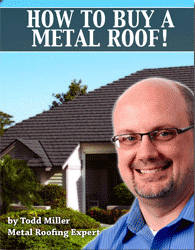Exposed Fastener Metal Roofing: Is It Standing Seam?
April 6, 2013 | Filed under: A Little History, Metal Roofing, Roofing Answers
I get a lot of questions about exposed fastener metal roofing. Also called “screw-through” metal roofing or sometimes “channel drain”, these are rollformed products that are vertically oriented on the roof. They have some sort of corrugated wave or rib pattern formed into the panels. Some common names to the corrugated patterns are “R Panel,” “PBR Panel,” and “5V Crimp.” They are installed using screws that penetrate the panels, leaving the screwheads exposed.
Many people refer to these products as “standing seam” roofing. I have even heard contractors call them that. In fact, though, they are not standing seam metal roofing systems. Standing seam products do not have exposed fastener heads and they also have some sort of interlock joining the panels one to the next. Exposed fastener metal roofs have a simple overlap from one panel to the next. Also, whereas standing seam comes in continuous length panels with no seam from the bottom of the panel to the top, exposed fastener metal panels are often in standard lengths meaning there are horizontal overlaps from one panel up the roof to the next.
Exposed fastener panels have had extensive use in the agricultural markets, from barn roofs to metal buildings. Many of these products, depending upon their gauge and design, can be installed over battens or strapping rather than a solid roof deck. With the rapid growth in popularity and awareness of metal roofing in recent years, these products have ended up frequently installed on homes. They install easily and quickly in most cases.
However, when homeowners ask me about these products, I must tell them that may not be getting what they think they’re getting when they buy exposed fastener metal roofs. Most metal roofing customers make their purchase thinking they’re getting the full gamut of metal roofing benefits – long life expectancy, energy efficiency, increased home value, and no maintenance to name a few. In most cases, with exposed fastener metal roofing, though, they are not really getting these benefits.
Exposed fastened products, having been made largely for the very price conscious agricultural market, are often made from lower grade raw materials. They may be G60 (or even less) galvanized rather than G90. They may be AZ 45 galvalume. They may have polyester paint finishes rather than Kynar 500® and Hylar 5000® PVDF resin-based finishes. All of these things affect their life expectancy, often making these products 20 – 25 year products rather than the 50+ year products that homeowners want when they choose metal.
And then there are all of the fastener holes. The average through-fastened metal roof will have hundreds and even thousands of screws penetrating the panels. These screws have washers or grommets on them but those dry out and crack over time. Additionally, because exposed fastened products have no allowance for the metal’s natural expansion and contraction with thermal, cycling, the fastener holes “wallow out” over time. Fasteners can even break from the pressure and fatigue. Once all of this happens, water can penetrate the holes, jeopardizing the protection offered by the roof system and also setting off a process of corrosion of the metal.
As far as maintenance, again, the exposed screws are a problem. The forces from the metal expanding and contraction can cause the screws to loosen. They can be re-tightened but eventually to maintain the roof’s service life, the screws need to be replaced with new screws of slightly larger diameter.
Now, whenever folks ask me about these products, I tell them that they have a decision to make. While these products are indeed metal roofs and they do offer some of the benefits of metal roofing, they also have serious shortcomings. These shortcomings can even detract from, rather than increase, home value over time. Most folks who invest in a metal roof want it to last the life of their home. Exposed fastened metal roofs can leave them sadly short of that goal.
As always, I am happy to answer any specific questions you have about roofing or ventilation. You can email me at todd@asktoddmiller.com.
Kynar 500® is a registered trademark belonging to Arkema Inc.
Hylar 5000® is a registered trademark belonging to Solvay

Todd Miller has spent his entire career in the metal building products manufacturing industry. He is president of Isaiah Industries, an organization recognized as one of the world’s leading metal roofing manufacturers. Todd is currently Vice President of the MRA (Metal Roofing Association) and a Past Chair of MCA (Metal Construction Association). Through his website, he strives to raise the bar on standards and practices to provide property owners with the best possible products for successful roofing projects.
You may pull quotes from this article provided you include a link back to the original article on this site. You may not reprint this full article, or even a significant amount of the article, without explicit permission. To gain permission, click here.


Having been in sheet metal trade for over 40 years, hidden fasteners are way better, just for the fact you said ,Screws put holes though the metal weather it is a roof or flashing.
Excellent article ! Thanks
Have an r panel roof covering 18,ooo sqft warehouse. 18 years old. Have always had a leak here or there but now getting to be a problem. The screws that seem to be the problem are on top of the seams (not in the valleys where they are attached to perlins). Most won’t tighten but appear to be stripped. I can stop a leak(if I know where it is up there) by removing the screw,applying caulk, replaceing the screw and tightening until just before it slips or strips out.I also try to push caulk into where the seam overlap is. My question then is there a better way? If not can you recommend the proper caulk or sealer i should be using. Thanks
Kevin, First of all, just for all readers, I want to mention that exposed fastened products, while they work for commercial properties, are prone to maintenance and, for that reason, I do not suggest them for residential applications. The answer to your issue, Kevin, is to use larger diameter screws. The industry makes them for this specific purpose. I would suggest contacting companies such as Triangle Fastener or Atlas Bolt and Screw to see what they suggest specifically.
1. The sun UV and ozone work on the screw washer. 2. The fastener fails, letting water in. 3. The wood under the fastener rots and no longer accepts a replacement screw. 4. Tear off the whole mess and start over. It might take 20 years to happen, but it WILL happen!
Vacation cottage has had metal (over asphalt roofing) for sixty years and more. This vacation cottage is NOT heated in winter. Subject to hurricane and nor’easter (storms). Main cottage is 15 feet wide, 45 feet length – straight run. Bedroom each end, main room and tiny bath / shower and kitchen.
That’s fantastic! Are there any questions I can answer for you?
This is another great article, Todd. Very clearly written & informative! Thanks so much for sharing your expertise!
Hi my name is Vernie just learning about metal roofing would love your site to go by to ask you questions I may have about metal please great article thank you
Questions can be emailed to met at todd@asktoddmiller.com
My insurance company in Florida wants me to put a “peel and seal” secondary underlayment under the metal roof I plan to install. This will be about an extra $2000. Will it be worth the cost? From your comments, I gather it would not be needed for a Standing Seam roof, but may help with the Screw-down roof.
This sounds a little complicated. First, in Florida, there are many situations when a self adhering underlayment is required by code on the entire roof. If it is required by code in your case, then you have no choice. Next, if your insurance company is requesting it, I’d want to know why they are requesting it. I’d be very concerned if I were you that they could drop your insurance if you do not comply. That could then be a problem for other insurance companies and it also could be a problem for home inspectors should you ever sell your home. Finally, I am curious about the pitch of the roof and also what ventilation you have in the attic. Please feel free to reply with more information.
7/12 pitch with ridge vents. Apparently the FL code changed in 2007 to require SWR, but my contractor says that was deleted a year later. My insurance company still thinks it is a good idea, and offers an annual discount of $169, no matter what type of roof. So that answers my question. Thanks.
Hi Todd- we are building in Charleston, SC and I love the look (and lower price) of the 5V exposed screws roof vs the standing seam. Is it really that bad to get the 5V? I see it everywhere here! Thanks
Thank you. I appreciate your question because 5V Crimp is a look that is common in that area, and every attractive. There are ways to increase the quality of these installations. Do I think they will last as long as a concealed and clip fastened product? No. But they are not as costly either. I would encourage the use of high quality screws for the fasteners. I would even go so far as to suggest stainless steel screws. I also would suggest a product that has a paint finish, preferably a PVDF coating, rather than a clear coat on the metal. The paint will extend the product life considerably. Finally if you’re within 5 miles of the salt coast, I would consider aluminum over steel. If you’re within two miles, you need to see what warranty on your steel product will apply to your installation, if any. Good luck with your new home. Feel free to contact me anytime. I can be emailed at todd@asktoddmiller.com
Mr. Miller, thank you for exactly what I was looking for. I got three estimate for my roof. Asphalt, 26GA Galvalume 5V crimp, & 24 GA of the same. Asphalt $12,200, 26GA $18,000, & 24GA $24,800. The later is a bit too much for me & now the 26GA with exposed screws are much less desirable now after reading your article. So, I guess I’m going back with asphalt. The bottom line I suppose, “is you get what you pay for” in most cases. Thanks again for putting this article out for all of us.
Ultimately, yes, we get what we pay for. One thing I have seen a few folks do, and this may interest you not at all, is buy a quality metal shingle or standing seam and install it themselves for something similar price-wise to professionally-installed asphalt shingles. Please contact me anytime!